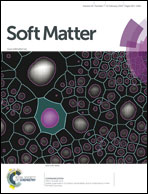Confining ss-DNA/carbon nanotube complexes in ordered droplets
Abstract
In 1/1 mass ratio mixtures made of single strand DNA and single-walled carbon nanotubes lyotropic nematic phases are formed. The process is assisted by segregative phase separation procedures. The liquid crystalline order occurring therein was confirmed by optical polarizing microscopy and zero-shear rheology. The resulting nematic droplets were dispersed in protein or cationic surfactant solutions, under appropriate pH and/or ionic strength conditions. The components of the hosting fluid(s) rapidly adsorb onto the droplets, form a permanent peel on their surface, and confine them. The peel resists osmotic gradients and has significant stability. The distribution of the species in the droplet and in the peel was determined by SEM. Data indicate that the peel contains protein or surfactant, depending on the titrant, when the core is rich in DNA and nanotubes. According to electron microscopy, nematic order in the droplets is partly retained.


 Please wait while we load your content...
Please wait while we load your content...